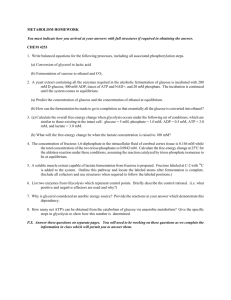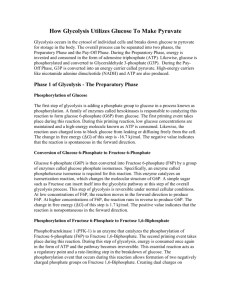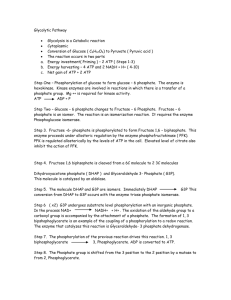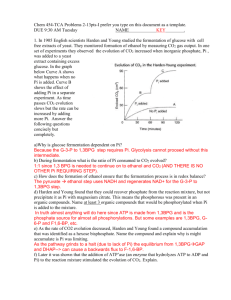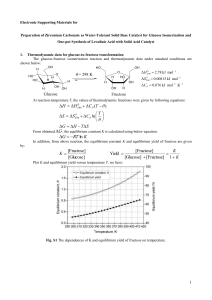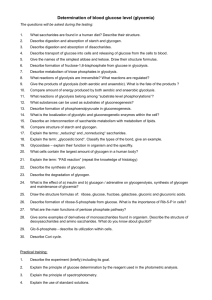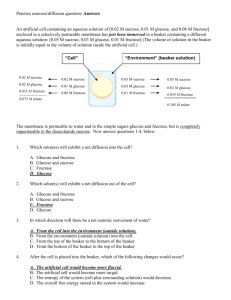Dear Notetaker - My ICO Portal
advertisement
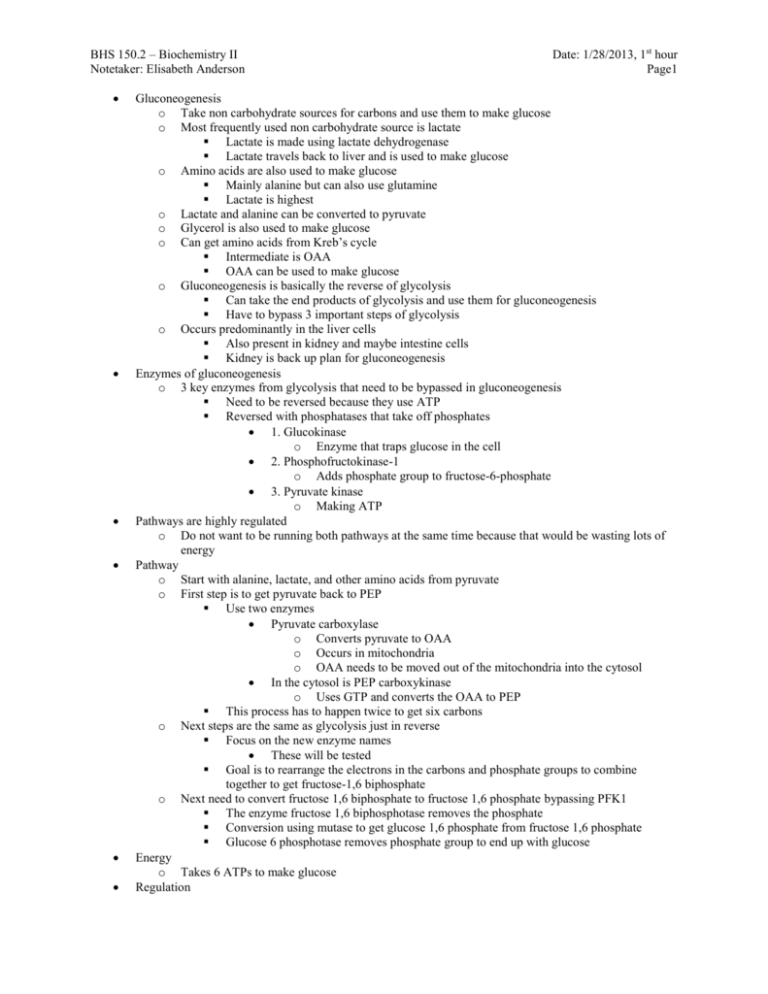
BHS 150.2 – Biochemistry II Notetaker: Elisabeth Anderson Date: 1/28/2013, 1st hour Page1 Gluconeogenesis o Take non carbohydrate sources for carbons and use them to make glucose o Most frequently used non carbohydrate source is lactate Lactate is made using lactate dehydrogenase Lactate travels back to liver and is used to make glucose o Amino acids are also used to make glucose Mainly alanine but can also use glutamine Lactate is highest o Lactate and alanine can be converted to pyruvate o Glycerol is also used to make glucose o Can get amino acids from Kreb’s cycle Intermediate is OAA OAA can be used to make glucose o Gluconeogenesis is basically the reverse of glycolysis Can take the end products of glycolysis and use them for gluconeogenesis Have to bypass 3 important steps of glycolysis o Occurs predominantly in the liver cells Also present in kidney and maybe intestine cells Kidney is back up plan for gluconeogenesis Enzymes of gluconeogenesis o 3 key enzymes from glycolysis that need to be bypassed in gluconeogenesis Need to be reversed because they use ATP Reversed with phosphatases that take off phosphates 1. Glucokinase o Enzyme that traps glucose in the cell 2. Phosphofructokinase-1 o Adds phosphate group to fructose-6-phosphate 3. Pyruvate kinase o Making ATP Pathways are highly regulated o Do not want to be running both pathways at the same time because that would be wasting lots of energy Pathway o Start with alanine, lactate, and other amino acids from pyruvate o First step is to get pyruvate back to PEP Use two enzymes Pyruvate carboxylase o Converts pyruvate to OAA o Occurs in mitochondria o OAA needs to be moved out of the mitochondria into the cytosol In the cytosol is PEP carboxykinase o Uses GTP and converts the OAA to PEP This process has to happen twice to get six carbons o Next steps are the same as glycolysis just in reverse Focus on the new enzyme names These will be tested Goal is to rearrange the electrons in the carbons and phosphate groups to combine together to get fructose-1,6 biphosphate o Next need to convert fructose 1,6 biphosphate to fructose 1,6 phosphate bypassing PFK1 The enzyme fructose 1,6 biphosphotase removes the phosphate Conversion using mutase to get glucose 1,6 phosphate from fructose 1,6 phosphate Glucose 6 phosphotase removes phosphate group to end up with glucose Energy o Takes 6 ATPs to make glucose Regulation BHS 150.2 – Biochemistry II Notetaker: Elisabeth Anderson o Date: 1/28/2013, 1st hour Page2 Cori cycle - Compartmentalization Lactate is most commonly made in the muscle Excellent at working under low oxygen conditions o Produces lactate or lactic acid o This then moves out into the blood and travels to the liver o The liver uses the lactate for gluconeogenesis Glycolysis occurs in the muscle and gluconeogenesis occurs in the liver Occurring in different places so it is easily regulated Two times when gluconeogenesis is highest During exercise involving the muscles or weight lifting puts the body under stress and produces lactic acid stimulating gluconeogenesis Under dietary restrictions when you aren’t taking in glucose Regulated by pathway itself Two key regulation points o Fructose 2,6 biphosphate Regulatory compound Indication of what is needed Do I need glycolysis to speed up or gluconeogenesis to speed up? When there is a lot of fructose 2,6 biphosphate available this means that there is a back-up of fructose 6 phosphate Normally fructose 6 phosphate is converted to fructose 1,6 biphosphate by the enzyme PFK1 When there is a lot of fructose 6 phosphate another enzyme PFK2 will be activated to convert fructose 6 phosphate to fructose 2,6 biphosphate PFK2 is regulated by phosphorylation levels When phosphorylated it is inactive When dephosphorylated it is active Fructose 2,6 biphosphotase will reverse the process and break down fructose 2,6 biphosphate to fructose 6 phosphate This fructose 6 phosphate can be used in either glycolysis or gluconeogenesis wherever it is needed Scenario Glycolysis is happening a lot Fructose 6 phosphate is normally converted to fructose 1,6 biphosphate by PFK1 There is a backup of fructose 6 phosphate This means there is more fructose 6 phosphate than fructose 1,6 biphosphate This excess causes PFK2 to become activated PFK2 causes fructose 6 phosphate to be converted to fructose 2,6 biphosphate Fructose 2,6 biphosphate will stimulate PFK1 Fructose 2,6 biphosphate says to PFK1 “lets speed glycolysis up” Need to be able to use all the glucose that is coming in so it needs to work faster Once fructose 6 phosphate levels start to decline because glycolysis becomes more efficient PFK2 will no longer be active but fructose 2,6 biphosphotase will be active Fructose 2,6 biphosphate cannot be used for anything so it must be broken down by fructose 2,6 biphosphotase back into fructose 6 phosphate so it can go through the rest of glycolysis This removes the stimulus on PFK1 which is a signal to the cell that glycolysis can be slowed back down To keep the process moving forward so that the fructose 1,6 biphosphate that was just made is not immediately converted back to fructose 6 phosphate fructose 1,6 biphosphotase is inhibited by fructose 2,6 biphosphate BHS 150.2 – Biochemistry II Notetaker: Elisabeth Anderson Date: 1/28/2013, 1st hour Page3 This inhibits gluconeogenesis and moves the process forward Fructose 2,6 biphosphate is the key for regulation 1- part of glycolysis or gluconeogenesis (PFK1, fructose 1,6 biphosphate, fructose 1,6 biphosphotase) 2- part of regulation and never fed into glycolysis (PFK2, fructose 2,6 biphosphate, fructose 2,6 biphosphotase) o Regulated by pyruvate kinase Pyruvate kinase is regulated by insulin and glucagon When insulin is around pyruvate kinase is active o Lots of glucose coming in so want to be able to use it by putting it through glycolysis Insulin dephosphorylates pyruvate kinase and makes it active Glucagon will add a phosphate group and make it inactive o When glucose levels are lower o So we want to inactivate pyruvate kinase to allow pyruvate carboxykinase and PEP carboxykinase to be active so gluconeogenesis will occur o Want gluconeogenesis to be occurring, not glycolysis so more glucose can be made o PEP carboxykinase will feed up through gluconeogenesis Insulin and glucagon regulate PFK2 and fructose 2,6 biphosphotase through the same type of mechanism that pyruvate kinase is regulated o Whenever it is dephosphorylated it is active o When it is phosphorylated it is inactive Ketone bodies o Other metabolic fuel that the cell can be used o Used under conditions of fasting or starvation o Become relevant when we have moved away from the supply of glucose What can happen to glucose? o It gets converted to glucose 6 phosphate o Then it goes into glycolysis or it can be used to make glycogen o It is regulated by glucagon and insulin o If the glucose 6 phosphate goes through glycolysis you can get: energy from the Kreb’s cycle Acetyl CoA for fatty acid synthesis Can go through pentose phosphate pathway to make NADPH Acetyl CoA for Kreb’s cycle o How does the cell determine what to do with all the stuff? How is the process regulated? Hormonal regulators o Insulin is around when there is an abundance of glucose o Glucose is around when there are low amounts of glucose Always a balance of the two hormones Insulin stimulates Fatty acid synthesis Glycogenesis: the building of glycogen Glycolysis Lipogenesis: building of lipids Protein synthesis Glucagon stimulates Fatty acid oxidation to release the acetyl coA to make energy Gluconeogenesis Glycogenolysis: the breakdown of glycogen Lipolysis: breakdown of lipids BHS 150.2 – Biochemistry II Notetaker: Elisabeth Anderson Date: 1/28/2013, 1st hour Page4 Proteolysis
